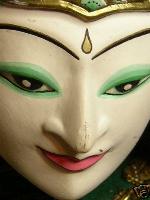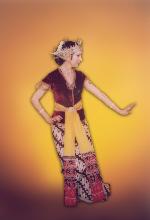 Indonesia is home to many traditional dance styles, none more famous than the revered dance traditions of Java and Bali. Although dynamically impacted by Hinduism and Buddhism from the 6th - 7th centuries, the form of Javanese dance has evolved over the last 250 years from the culture of Java’s former Islamic-influenced courts.
Classical dance in Java has existed for centuries. The first evidence of these dances can be seen in the bas-reliefs on the Borobudur Temple, in central Java, constructed in the 8th century A.D. The unique blending of the import of religion, arts, and philosophy from India, China, and South East Asia, with the already existing indigenous Javanese culture, resulted in a dynamic meeting of these three cultures. Later, Javanese dance became the property of the royal court, which expressed a high standard of refined beauty and was performed during ceremonies in the palaces.
Indonesia is home to many traditional dance styles, none more famous than the revered dance traditions of Java and Bali. Although dynamically impacted by Hinduism and Buddhism from the 6th - 7th centuries, the form of Javanese dance has evolved over the last 250 years from the culture of Java’s former Islamic-influenced courts.
Classical dance in Java has existed for centuries. The first evidence of these dances can be seen in the bas-reliefs on the Borobudur Temple, in central Java, constructed in the 8th century A.D. The unique blending of the import of religion, arts, and philosophy from India, China, and South East Asia, with the already existing indigenous Javanese culture, resulted in a dynamic meeting of these three cultures. Later, Javanese dance became the property of the royal court, which expressed a high standard of refined beauty and was performed during ceremonies in the palaces.
Starting at the beginning of this century and especially during the last few decades many new dances have been created from more modern inspiration. The core of Javanese dance is inspired by nature. The movements must flow like a river, and be as effortless as clouds drifting across a blue sky. Traces of Hindu and Buddhist art are seen in the use of stylized poses and in the extraordinary usage of articulated hands and fingers. There is also a strong Taoist influence and similarity to Tai Chi in the slow and flowing meditative quality of the dance patterns, which allow the movements and poses to be connected seamlessly. Visions of a higher world, of inner bliss, extreme refinement, elegance, and tranquil self-possession, express the highest ideal of all Javanese arts. The dancers’ downcast eyes suggest seeing deeply, beyond the material world of phenomena; their dress and ornaments are those of apsaras (angelic beings).
The traditional Indonesian 20-piece orchestra is called a gamelan. It consists of gongs and sets of cast bronze bowls fitted into frames of elaborately carved wood, painted gold with red lacquer. Like the music of the gamelan which accompanies it, Javanese dance is highly complex and structured, subtle and gracious. The movements are built from units of eight counts, and are adjusted to the pace of the music.

